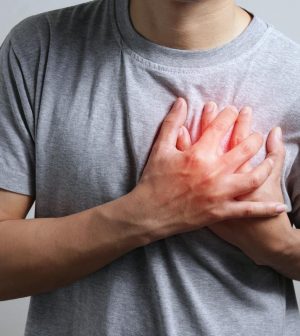- Understanding the Connection Between Anxiety and Depression
- How Daily Prunes Can Influence Cholesterol and Inflammation
- When to Take B12 for Better Absorption and Energy
- Epsom Salts: Health Benefits and Uses
- See What Saffron Can Do for Sleep and Heart Health
- 6 Common Mistakes to Avoid Before Your Physical
- Can Sweating Really Help You Beat a Cold?
- Strengthening Your Relationship: Practical Strategies
- Skip Storing This Everyday Product in the Fridge Door
- Green Tea + B3 Pairing May Boost Brain Health
Hourglass-Shaped Stent Might Ease Tough-to-Treat Angina

Recurring angina chest pain in people with a certain type of heart disease can be tough to treat, but a new hourglass-shaped stent could be a real advance, researchers report.
People with what’s known as microvascular disease — impeded blood flow in tiny blood vessels within the heart — improved significantly once they got the new stent, according to researchers at the Mayo Clinic in Rochester, Minn.
That’s a big turnaround, since “the patients with heart-related microvascular dysfunction in this study had little ability to control their chronic angina, which severely limited their day-to-day activities,” noted study senior author Dr. Amir Lerman, a Mayo cardiologist.
His team published its findings Nov. 6 in the Journal of the American College of Cardiology: Cardiovascular Interventions.
According to the American Heart Association, angina is not an illness but a symptom of heart disease.
“Angina is chest pain or discomfort caused when your heart muscle doesn’t get enough oxygen-rich blood,” the AHA says. “It may feel like pressure or squeezing in your chest. The discomfort also can occur in your shoulders, arms, neck, jaw, abdomen or back. Angina pain may even feel like indigestion.”
Recurrent chest pain is a hallmark of microvascular disease, Lerman’s team noted. Major arteries may not be blocked but much smaller blood vessels are, and as the heart’s blood supply is diminished, angina episodes occur.
Up to two-thirds of people who get a diagnostic coronary angiogram for chest pain do show signs of microvascular disease, the Mayo team said.
Recurrent angina can also be very debilitating, keeping people from the simple activities of daily life. There’s not a lot doctors can give patients in this scenario, besides prescribing certain medications or asking them to change to a healthier lifestyle.
Stents are, of course, used in other scenarios to open large arteries. The new stent, with its unique pinched-in-the-middle hourglass design, does seem to help restore blood flow to the tiny blood vessels, Lerman and colleagues found.
In a clinical trial involving 30 patients with microvascular disease and angina, more than three-quarters of patients saw meaningful improvements in their daily lives after receiving the stent, according to the Mayo team.
As they explained, that could mean that a person who couldn’t walk around the block or up a flight of stairs without experiencing chest pain before the stent was now able to perform those simple tasks easily, with no discomfort.
“Beyond reductions in chest pain and being able to comfortably handle more physical activity, the majority of patients in the study also showed a connection between the changes in their coronary flow reserve, which is a measure of maximum blood flow, and changes in their quality-of-life responses on the survey,” Lerman said in a Mayo news release. “This points to the link between the physiological measurement and angina symptoms.”
It’s thought that the stent’s unique design helps increase “back pressure,” on the heart’s smaller vessels, to better redistribute blood flow.
Still, the stent wasn’t foolproof, and 20% to 30% of patients got no relief from the device, the study also found. Why that is so is the focus of future research, Lerman said.
More information
Find out more about microvascular disease at the American Heart Association.
SOURCE: Mayo Clinic, news release, Nov. 7, 2024
Source: HealthDay
Copyright © 2026 HealthDay. All rights reserved.










